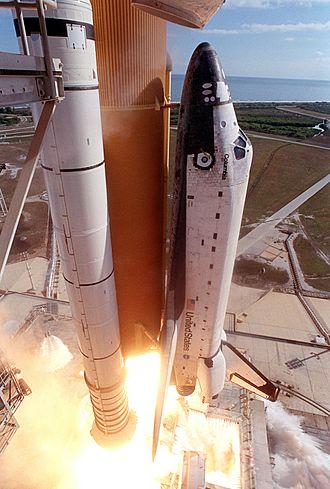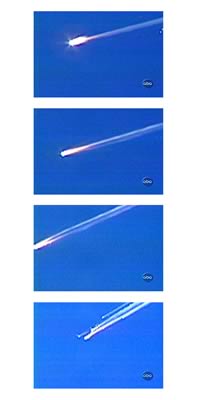Space Shuttle Columbia disaster facts for kids

Final launch of Columbia
|
|||||||||||||||
| Date | February 1, 2003 | ||||||||||||||
|---|---|---|---|---|---|---|---|---|---|---|---|---|---|---|---|
| Time | 08:59 EST (13:59 UTC) | ||||||||||||||
| Location | Over Texas and Louisiana | ||||||||||||||
| Cause | Wing damage from debris | ||||||||||||||
| Outcome | Shuttles grounded for 29 months | ||||||||||||||
| Deaths |
|
||||||||||||||
| Inquiries | Columbia Investigation Board | ||||||||||||||
The Space Shuttle Columbia disaster happened when the Space Shuttle Columbia (also known as OV-102) broke apart. This happened on February 1, 2003, as it was returning to Earth. A piece of foam broke off the fuel tank during launch. This foam hit the shuttle's wing, making a hole. When the shuttle came back into Earth's atmosphere, super hot gases got into the damaged wing. This caused the shuttle to break apart. Sadly, all seven astronauts on board died.
Pieces of Columbia were found scattered across Texas and Louisiana. The cockpit window is now on display at the Kennedy Space Center in Florida.
Contents
What Happened to Space Shuttle Columbia?
The Space Shuttle Columbia was on a mission called STS-107. It launched into space on January 16, 2003. During the launch, a piece of foam insulation broke off the external fuel tank. This foam hit the left wing of the shuttle. Engineers on the ground were worried. They thought the foam might have caused damage.
However, NASA managers decided the damage was not serious. They believed it would not affect the shuttle's safe return. So, the mission continued for 16 days.
Re-entry and Breakup
On February 1, 2003, Columbia began its journey back to Earth. As it entered the atmosphere, super hot gases surrounded the shuttle. These gases can reach temperatures of over 3,000 degrees Fahrenheit (1,650 degrees Celsius). Because of the hole in the wing, these hot gases got inside.
The heat quickly melted the wing's structure. This caused the shuttle to lose control and break apart. The breakup happened high above Texas. All seven astronauts on board died.
Who Were the Columbia Astronauts?
Seven brave astronauts were on the final mission of Space Shuttle Columbia. They were:
- Commander Rick D. Husband: A U.S. Air Force colonel and mechanical engineer. He was in charge of the mission.
- Pilot William C. McCool: A U.S. Navy commander. He helped fly the shuttle.
- Payload Commander Michael P. Anderson: A U.S. Air Force lieutenant colonel and physicist. He was in charge of the science experiments.
- Payload Specialist Ilan Ramon: A colonel in the Israeli Air Force. He was Israel's first astronaut.
- Mission Specialist Kalpana Chawla: An aerospace engineer born in India. She helped with many tasks during the mission.
- Mission Specialist David M. Brown: A U.S. Navy captain and surgeon. He helped with medical needs and other duties.
- Mission Specialist Laurel Blair Salton Clark: A U.S. Navy captain and surgeon. She also helped with medical and mission tasks.
These astronauts were scientists, engineers, and pilots. They were performing important research in space.
What We Learned from the Disaster
After the disaster, a group called the Columbia Accident Investigation Board looked into what happened. They found that the foam strike was the main cause. But they also found problems with how NASA handled safety.
The disaster taught NASA important lessons. It led to many changes in how space shuttles were built and operated. For example, they improved how they checked for damage during launch. The Space Shuttle fleet was grounded for 29 months after the accident. This means no shuttles flew during that time.
The Columbia disaster, along with the Space Shuttle Challenger disaster in 1986, showed the risks of space travel. It also led to the end of the Space Shuttle program. NASA then focused on new ways to send astronauts to space.
Images for kids
-
Columbia reentry image taken at the Starfire Optical Range near Albuquerque, New Mexico. Debris is visible coming from the left wing (bottom).
-
Mock-up of an orbiter's wing's leading edge made with an RCC-panel taken from Atlantis. Simulation of known and possible conditions of the foam impact on Columbia's final launch showed brittle fracture of RCC.
-
A makeshift memorial at the main entrance to the Lyndon B. Johnson Space Center in Houston, Texas
-
Columbia memorial on Mars Exploration Rover Spirit
See also
 In Spanish: Accidente del transbordador espacial Columbia para niños
In Spanish: Accidente del transbordador espacial Columbia para niños













